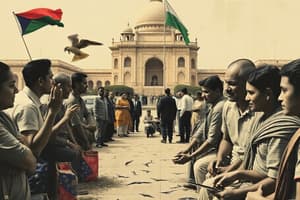Podcast
Questions and Answers
What is one of the main reasons the Constitution of India provides safeguards for minority communities?
What is one of the main reasons the Constitution of India provides safeguards for minority communities?
- To promote cultural domination by the majority
- To enhance economic opportunities for wealthy individuals
- To encourage majority communities to assimilate minorities
- To protect against discrimination and disadvantage (correct)
The Muslim community in India feels culturally similar to the majority due to shared attire.
The Muslim community in India feels culturally similar to the majority due to shared attire.
False (B)
How does economic marginalization affect social recognition?
How does economic marginalization affect social recognition?
Economic marginalization leads to social marginalization, resulting in lower respect and fewer opportunities.
The Indian Constitution aims to protect the rights of __________ communities.
The Indian Constitution aims to protect the rights of __________ communities.
Match the following aspects of minority protection to their descriptions:
Match the following aspects of minority protection to their descriptions:
Which of the following best describes the term 'Adivasis'?
Which of the following best describes the term 'Adivasis'?
Adivasis generally share a single culture and religious practice.
Adivasis generally share a single culture and religious practice.
Name two practices commonly observed by Adivasi communities.
Name two practices commonly observed by Adivasi communities.
Adivasis are marginalized due to their __________, customs, and beliefs.
Adivasis are marginalized due to their __________, customs, and beliefs.
Which of the following states has a significant Adivasi population?
Which of the following states has a significant Adivasi population?
Match the following Adivasi religious practices with their descriptions:
Match the following Adivasi religious practices with their descriptions:
Adivasi religious practices have no impact on the dominant religions surrounding them.
Adivasi religious practices have no impact on the dominant religions surrounding them.
List one reason that contributes to the marginalization of certain communities in India.
List one reason that contributes to the marginalization of certain communities in India.
What percentage of the tribal population is Orissa known for?
What percentage of the tribal population is Orissa known for?
Adivasis are often portrayed in non-stereotypical ways.
Adivasis are often portrayed in non-stereotypical ways.
What is one reason Adivasis have been forced to move from their lands?
What is one reason Adivasis have been forced to move from their lands?
Adivasis had deep knowledge of the ______ and control over most of the forested areas.
Adivasis had deep knowledge of the ______ and control over most of the forested areas.
Match the following Adivasi contributions and impacts of development:
Match the following Adivasi contributions and impacts of development:
Which of the following best describes a consequence of Adivasi displacement?
Which of the following best describes a consequence of Adivasi displacement?
Adivasis' rich cultural practices remain unimpacted by development activities.
Adivasis' rich cultural practices remain unimpacted by development activities.
Many Adivasis migrated to cities seeking ______ after being displaced.
Many Adivasis migrated to cities seeking ______ after being displaced.
Flashcards
Marginalization
Marginalization
Exclusion from the mainstream, leading to disadvantage, prejudice, poverty, and powerlessness, resulting in a lower social status and unequal access to resources.
Adivasis
Adivasis
Original inhabitants of India, often living in forests.
Adivasi Groups
Adivasi Groups
Over 500 different tribal groups in India, residing mainly in central, eastern, western and north eastern states.
Jati-Varna System
Jati-Varna System
Signup and view all the flashcards
Tribal Religions
Tribal Religions
Signup and view all the flashcards
Social Marginalization
Social Marginalization
Signup and view all the flashcards
Economic Marginalization
Economic Marginalization
Signup and view all the flashcards
Cultural Marginalization
Cultural Marginalization
Signup and view all the flashcards
Minority rights safeguards
Minority rights safeguards
Signup and view all the flashcards
Cultural dominance
Cultural dominance
Signup and view all the flashcards
Constitutional safeguards
Constitutional safeguards
Signup and view all the flashcards
Adivasi Stereotypes
Adivasi Stereotypes
Signup and view all the flashcards
Why Adivasis Were Forced to Move
Why Adivasis Were Forced to Move
Signup and view all the flashcards
Development's Impact on Adivasis
Development's Impact on Adivasis
Signup and view all the flashcards
Adivasi Languages
Adivasi Languages
Signup and view all the flashcards
Adivasi Influence on Empires
Adivasi Influence on Empires
Signup and view all the flashcards
Adivasi Resistance
Adivasi Resistance
Signup and view all the flashcards
Adivasi Poverty and Deprivation
Adivasi Poverty and Deprivation
Signup and view all the flashcards
Adivasi Contribution to Development
Adivasi Contribution to Development
Signup and view all the flashcards
Study Notes
Marginalization
- Marginalization means exclusion from the mainstream, linked to disadvantage, prejudice, poverty, and powerlessness.
- Marginalization results in low social status and unequal access to resources.
- Reasons for marginalization include: language, customs, beliefs, poverty, low social status, level of literacy, lack of opportunities, and less access to resources. Smaller communities may also face marginalization.
- Marginalization can be based on social, economic, cultural, or political aspects.
Adivasis
- Adivasis are the "original inhabitants," often living in forests.
- Over 500 different Adivasi groups exist in India.
- They live in states such as Jharkhand, Madhya Pradesh, Odisha, Gujarat, Maharashtra, Rajasthan, Andhra Pradesh, West Bengal, and parts of the northeast.
- Adivasi communities are not structured hierarchically like the jati-varna system.
- They practice diverse tribal religions, often worshipping ancestors, mountain spirits, river spirits, and nature spirits.
Adivasi Stereotypes and Contributions
- Stereotypical portrayals often depict Adivasis as exotic, primitive, strange, unusual, and backward.
- Adivasis have deep knowledge of and control over forested areas.
- Forests under Adivasi control were not ruled by large states. Adivasis often provided access to forest resources.
- Reasons for Adivasi displacement include: military activity in the northeast, deforestation for timber and agriculture, exploitation of resources, and dam construction.
Muslims
- Muslims are a significant religious minority in India (13.4% of the population).
- They face marginalization and are often deprived of benefits such as literacy and employment.
- They practice customs that may be distinct from other communities.
- Common clothing practices, like burqas, or fez caps can be associated with stereotypes.
- Stigmatization may lead to social marginalization and ghettos.
Minority Safeguards in India's Constitution
- The constitution protects minority rights and safeguards against cultural domination by the majority.
- Safeguards are designed to protect minorities from discrimination and cultural domination.
- The constitution seeks to promote equality and justice.
- Economic and social conditions are connected. Poverty can result in social marginalization.
Studying That Suits You
Use AI to generate personalized quizzes and flashcards to suit your learning preferences.
Related Documents
Description
This quiz explores the concepts of marginalization and the Adivasi community, the original inhabitants of India. Learn about the challenges faced by marginalized groups and the cultural diversity among Adivasi communities. Test your knowledge on the social, economic, and political aspects that contribute to their status.




